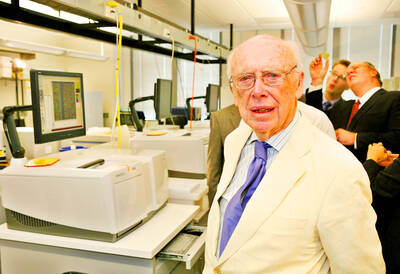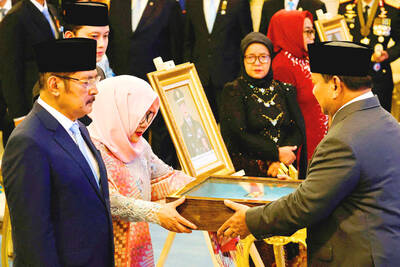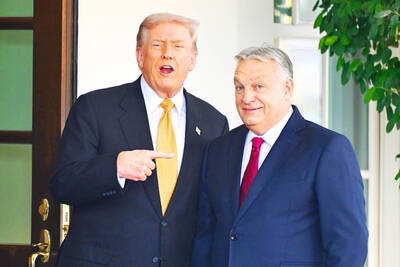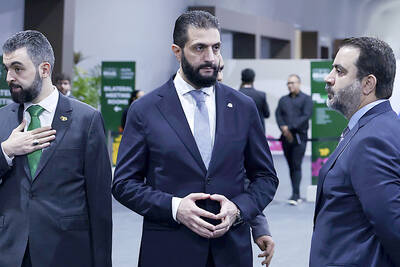Every winter, tourists from frozen homelands in the north fill the sunny streets of Old Havana, admiring its picturesque colonial buildings and centuries-old squares.
They sip mojitos in the Bodeguita del Medio where Ernest Hemingway supposedly hung out, eat in atmospheric restaurants along Calle Obispo and stay in lovely old hotels restored to their former glory as part of a massive remake of Havana’s historic center by the Cuban government.
But if they walk a few blocks on, they leave the manicured surroundings and emerge into a different Old Havana, where broken, unpainted buildings line pothole-filled streets and history is not recreated, but lived in a continuum of decay.

PHOTO: REUTERS
There, people live in rundown apartments, get their monthly food ration at spartan government stores and buy their drink at state-run shops where wine and rum are served in old water bottles.
With its two very different faces, Old Havana is both the centerpiece of Cuban tourism and a symbol of the city’s larger problems.
Cuba’s capital, founded beside Havana Bay by the Spaniards in 1519, is a place where the past is remarkably intact, but thousands of its historic buildings are threatened by neglect and the government’s inability to preserve them.
In a race against time, time is winning, except in part of Old Havana where more than 350 buildings have been restored in a widely praised operation led by city historian Eusebio Leal.
He and a group of colleagues began the effort in 1967, but it took wings in 1994 when then-president Fidel Castro put Leal in charge of a state company to restore the old quarter using profits from the money spent there by tourists.
“We define our battle in Old Havana as a defense of utopia,” Leal said in an interview.
He said tourist spending allowed him to invest US$20 million in the project last year as half a million visitors traipsed through Old Havana.
The amount of money is small compared to the need, he said. A pre-restoration study found 4,000 buildings in Old Havana’s 3.4km² area virtually all historically valuable and in bad shape.
Leal would like to expand preservation to historic neighborhoods like Central Havana and Vedado and has done a few renovations outside of Old Havana as “sources of inspiration.”
“But economic resources are decisive, and we cannot stray too far from the source, nor the idea of the core,” he said.
Havana is a treasure trove of architectural history with block after block of historic buildings in styles ranging from colonial to modernism. Most need repair and many have already fallen.
When Hurricane Ike brushed the city in 2008, 67 buildings collapsed, raising fears about what will happen when a big storm hits Havana head on.
The most basic problem is a lack of maintenance for many years following the 1959 revolution that transformed Cuba into a communist state. The new government focused on building infrastructure in the impoverished countryside and basically ignored Havana.
Leal said Cuba does not have the money to do more, in part because of the longstanding US trade embargo against the island.
“We have lived for more than 50 years in an economic and commercial war,” he said.
Government opponents blame the communist system Fidel Castro put in place and the economic woes that followed.
Leal argues that the revolution saved historic Havana from Cuban capitalists, who he said had plans to replace old buildings with new, even in Old Havana.
“Without socialism, Old Havana would not be preserved,” he said.
About 6 percent of Old Havana restoration funds come from organizations such as the UN, but more could be done if the government allowed greater private investment from abroad, said Bernd Herrmann, head of the Havana-based Swiss travel agency Cuba Real Tours.
Cuba has a problem in that many visitors come but, because of insufficient tourist infrastructure and poor service, do not return, Herrmann said.
“If they would let in investors, the satisfaction of the clients would be greater. We’d have more repeaters,” he said.

James Watson — the Nobel laureate co-credited with the pivotal discovery of DNA’s double-helix structure, but whose career was later tainted by his repeated racist remarks — has died, his former lab said on Friday. He was 97. The eminent biologist died on Thursday in hospice care on Long Island in New York, announced the Cold Spring Harbor Laboratory, where he was based for much of his career. Watson became among the 20th century’s most storied scientists for his 1953 breakthrough discovery of the double helix with researcher partner Francis Crick. Along with Crick and Maurice Wilkins, he shared the

OUTRAGE: The former strongman was accused of corruption and responsibility for the killings of hundreds of thousands of political opponents during his time in office Indonesia yesterday awarded the title of national hero to late president Suharto, provoking outrage from rights groups who said the move was an attempt to whitewash decades of human rights abuses and corruption that took place during his 32 years in power. Suharto was a US ally during the Cold War who presided over decades of authoritarian rule, during which up to 1 million political opponents were killed, until he was toppled by protests in 1998. He was one of 10 people recognized by Indonesian President Prabowo Subianto in a televised ceremony held at the presidential palace in Jakarta to mark National

US President Donald Trump handed Hungarian Prime Minister Viktor Orban a one-year exemption from sanctions for buying Russian oil and gas after the close right-wing allies held a chummy White House meeting on Friday. Trump slapped sanctions on Moscow’s two largest oil companies last month after losing patience with Russian President Vladimir Putin over his refusal to end the nearly four-year-old invasion of Ukraine. However, while Trump has pushed other European countries to stop buying oil that he says funds Moscow’s war machine, Orban used his first trip to the White House since Trump’s return to power to push for

LANDMARK: After first meeting Trump in Riyadh in May, al-Sharaa’s visit to the White House today would be the first by a Syrian leader since the country’s independence Syrian President Ahmed al-Sharaa arrived in the US on Saturday for a landmark official visit, his country’s state news agency SANA reported, a day after Washington removed him from a terrorism blacklist. Sharaa, whose rebel forces ousted long-time former Syrian president Bashar al-Assad late last year, is due to meet US President Donald Trump at the White House today. It is the first such visit by a Syrian president since the country’s independence in 1946, according to analysts. The interim leader met Trump for the first time in Riyadh during the US president’s regional tour in May. US envoy to Syria Tom Barrack earlier